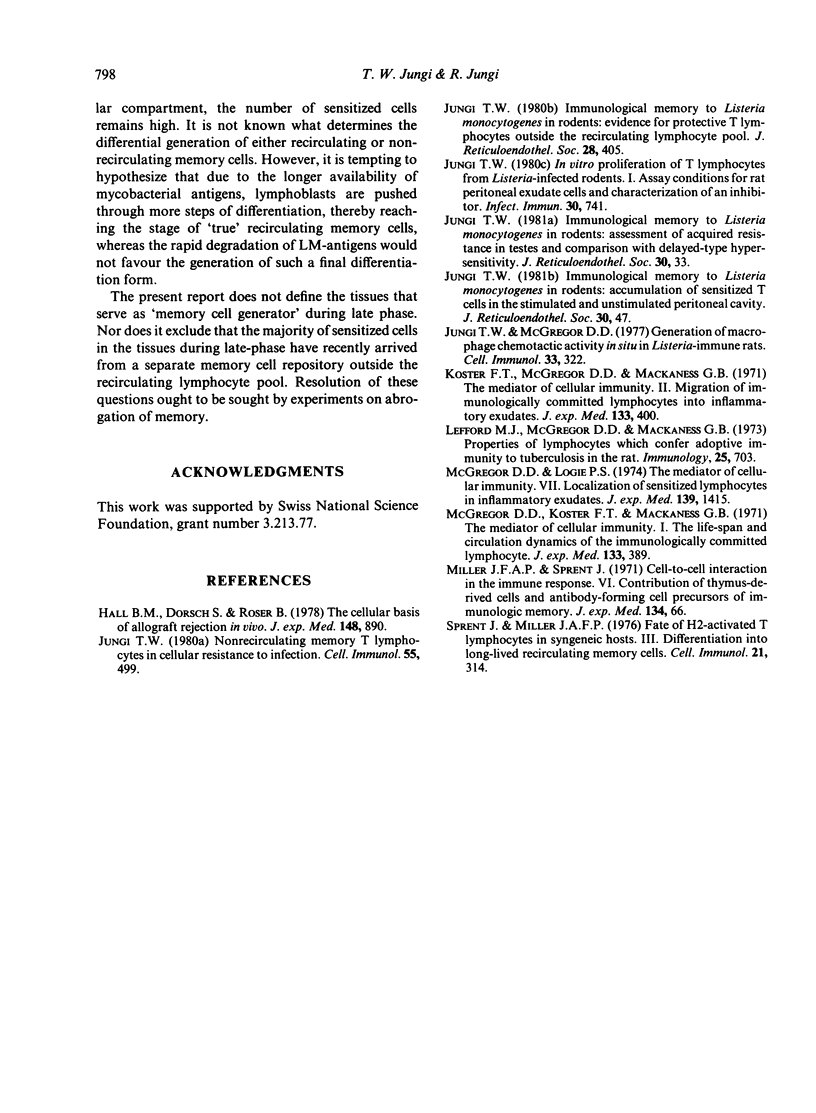Abstract
In this report on memory T cells mediating anti-microbial resistance to Listeria monocytogenes (LM) it was analysed whether memory cells found in tissue during late-phase (e.g. 10-60 days after infection) are long-lived progeny of cells which settled in tissues during early phase (e.g. 4-10 days after infection), or whether they are short lived but constantly replaced from other sources of memory cells. The study provides evidence for both mechanisms. Transfer and parabiosis experiments as well as radiometric and autoradiographic studies suggested that early-phase cells give rise to late-phase memory cells in the extravascular compartment. These memory cells were shown to mediate resistance and respond to antigen in vitro. Mediators of resistance in the unstimulated peritoneal cavity during late-phase are long-lived. On the other hand, parabiosis studies suggested that late-phase resident peritoneal cells which mediate resistance and respond to antigen in vitro have in part arrived after the end of early phase. Such cells are found in low numbers in central lymph during late-phase. The simplest interpretation of these data is that LM-specific lymphoblasts spontaneously extravasate and settle in tissues as long-lived memory cells. Since the numbers of LM-specific lymphoblasts released from lymphoid tissue is highest during early phase, the majority of resident memory cells are progeny of early-phase lymphoblasts.
Full text
PDF









Images in this article
Selected References
These references are in PubMed. This may not be the complete list of references from this article.
- Hall B. M., Dorsch S., Roser B. The cellular basis of allograft rejection in vivo. II. The nature of memory cells mediating second set heart graft rejection. J Exp Med. 1978 Oct 1;148(4):890–902. doi: 10.1084/jem.148.4.890. [DOI] [PMC free article] [PubMed] [Google Scholar]
- Jungi T. W. Immunological memory to Listeria monocytogenes in rodents: accumulation of Listeria-reactive lymphocytes in the stimulated and unstimulated peritoneal cavity. J Reticuloendothel Soc. 1981 Jul;30(1):47–59. [PubMed] [Google Scholar]
- Jungi T. W. Immunological memory to listeria monocytogenes in rodents: assessment of acquired resistance in testes and comparison with delayed-type hypersensitivity. J Reticuloendothel Soc. 1981 Jul;30(1):33–45. [PubMed] [Google Scholar]
- Jungi T. W. In vitro proliferation of T lymphocytes from Listeria-infected rodents: assay conditions for rat peritoneal exudate cells and characterization of an inhibitor. Infect Immun. 1980 Dec;30(3):741–752. doi: 10.1128/iai.30.3.741-752.1980. [DOI] [PMC free article] [PubMed] [Google Scholar]
- Jungi T. W., McGregor D. D. Generation of macrophage chemotactic activity in situ in Listeria-immune rats. Cell Immunol. 1977 Oct;33(2):322–339. doi: 10.1016/0008-8749(77)90162-9. [DOI] [PubMed] [Google Scholar]
- Jungi T. W. Nonrecirculating memory T lymphocytes in cellular resistance to infection. Cell Immunol. 1980 Oct;55(2):499–505. doi: 10.1016/0008-8749(80)90181-1. [DOI] [PubMed] [Google Scholar]
- Koster F. T., McGregor D. D., Mackaness G. B. The mediator of cellular immunity. II. Migration of immunologically committed lymphocytes into inflammatory exudates. J Exp Med. 1971 Feb 1;133(2):400–409. doi: 10.1084/jem.133.2.400. [DOI] [PMC free article] [PubMed] [Google Scholar]
- Lefford M. J., McGregor D. D., Mackaness G. B. Properties of lymphocytes which confer adoptive immunity to tuberculosis in rats. Immunology. 1973 Oct;25(4):703–715. [PMC free article] [PubMed] [Google Scholar]
- McGregor D. D., Koster F. T., Mackaness G. B. The mediator of cellular immunity. I. The life-span and circulation dynamics of the immunologically committed lymphocyte. J Exp Med. 1971 Feb 1;133(2):389–399. doi: 10.1084/jem.133.2.389. [DOI] [PMC free article] [PubMed] [Google Scholar]
- McGregor D. D., Logie P. S. The mediator of cellular immunity. VII. Localization of sensitized lymphocytes in inflammatory exudates. J Exp Med. 1974 Jun 1;139(6):1415–1430. doi: 10.1084/jem.139.6.1415. [DOI] [PMC free article] [PubMed] [Google Scholar]
- Miller J. F., Sprent J. Cell-to-cell interaction in the immune response. VI. Contribution of thymus-derived cells and antibody-forming cell precursors to immunological memory. J Exp Med. 1971 Jul 1;134(1):66–82. doi: 10.1084/jem.134.1.66. [DOI] [PMC free article] [PubMed] [Google Scholar]
- Sprent J., Miller J. F. Fate of H2-activated T lymphocytes in syngeneic hosts. III. Differentiation into long-lived recirculating memory cells. Cell Immunol. 1976 Feb;21(2):314–326. doi: 10.1016/0008-8749(76)90059-9. [DOI] [PubMed] [Google Scholar]



